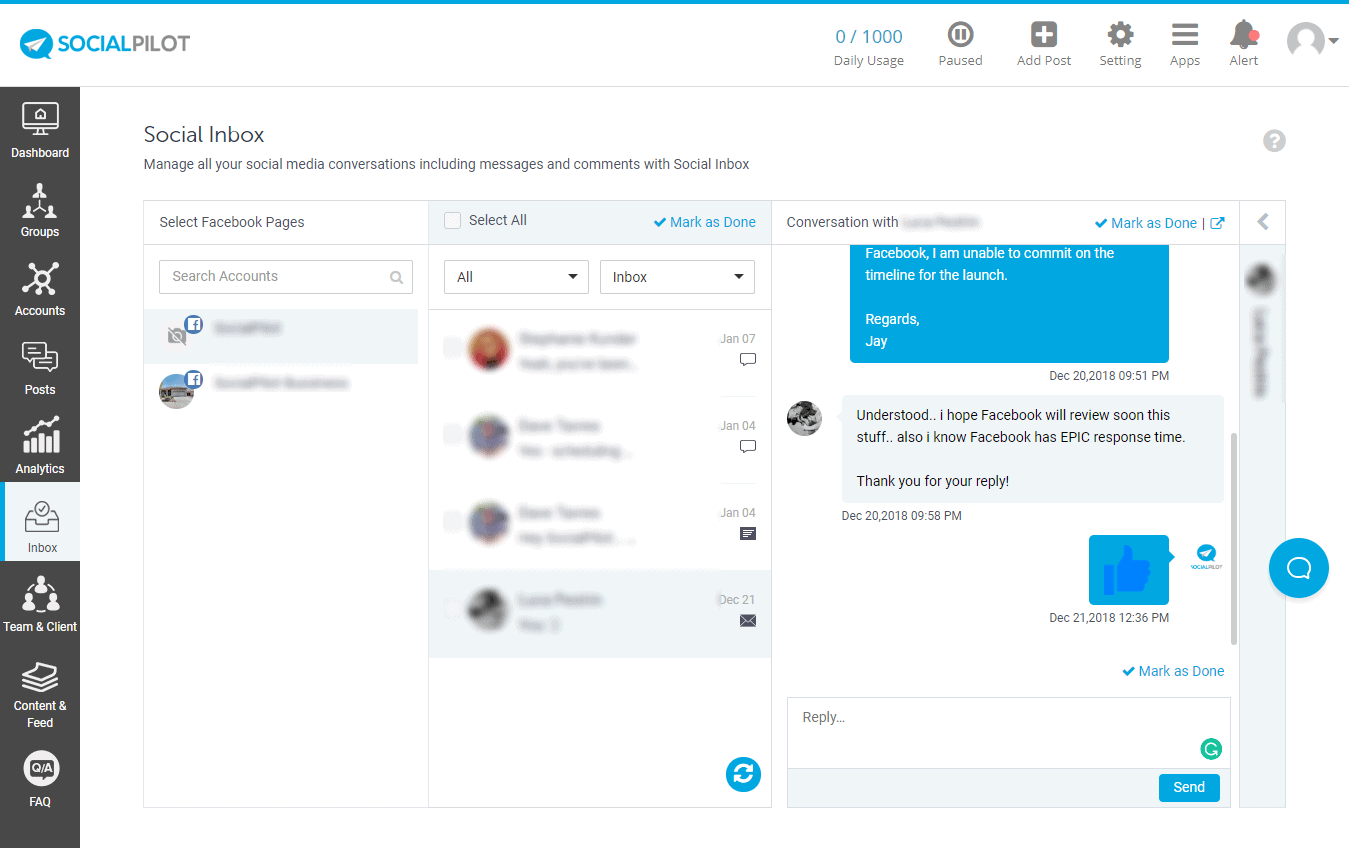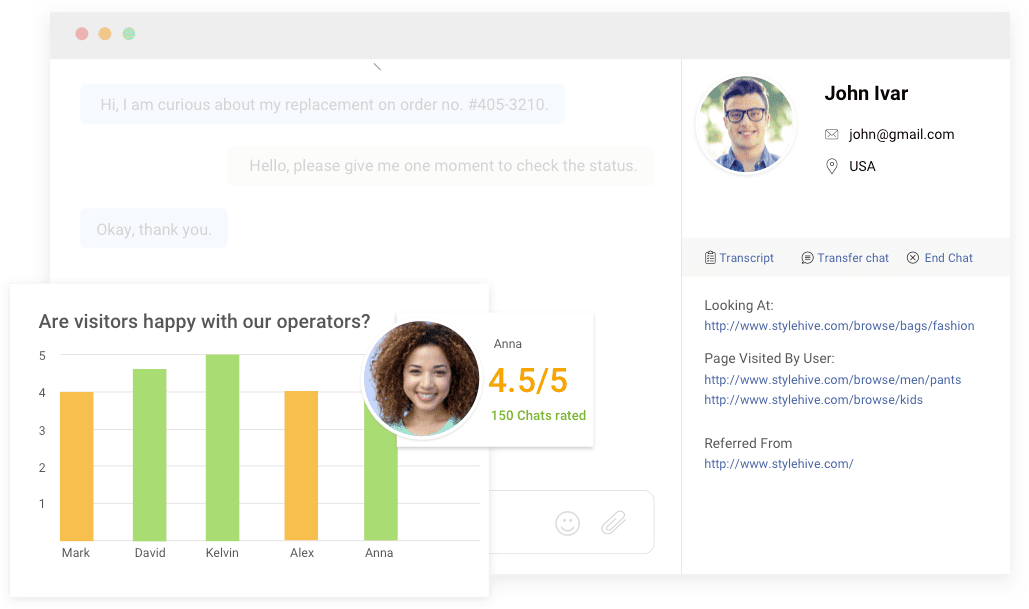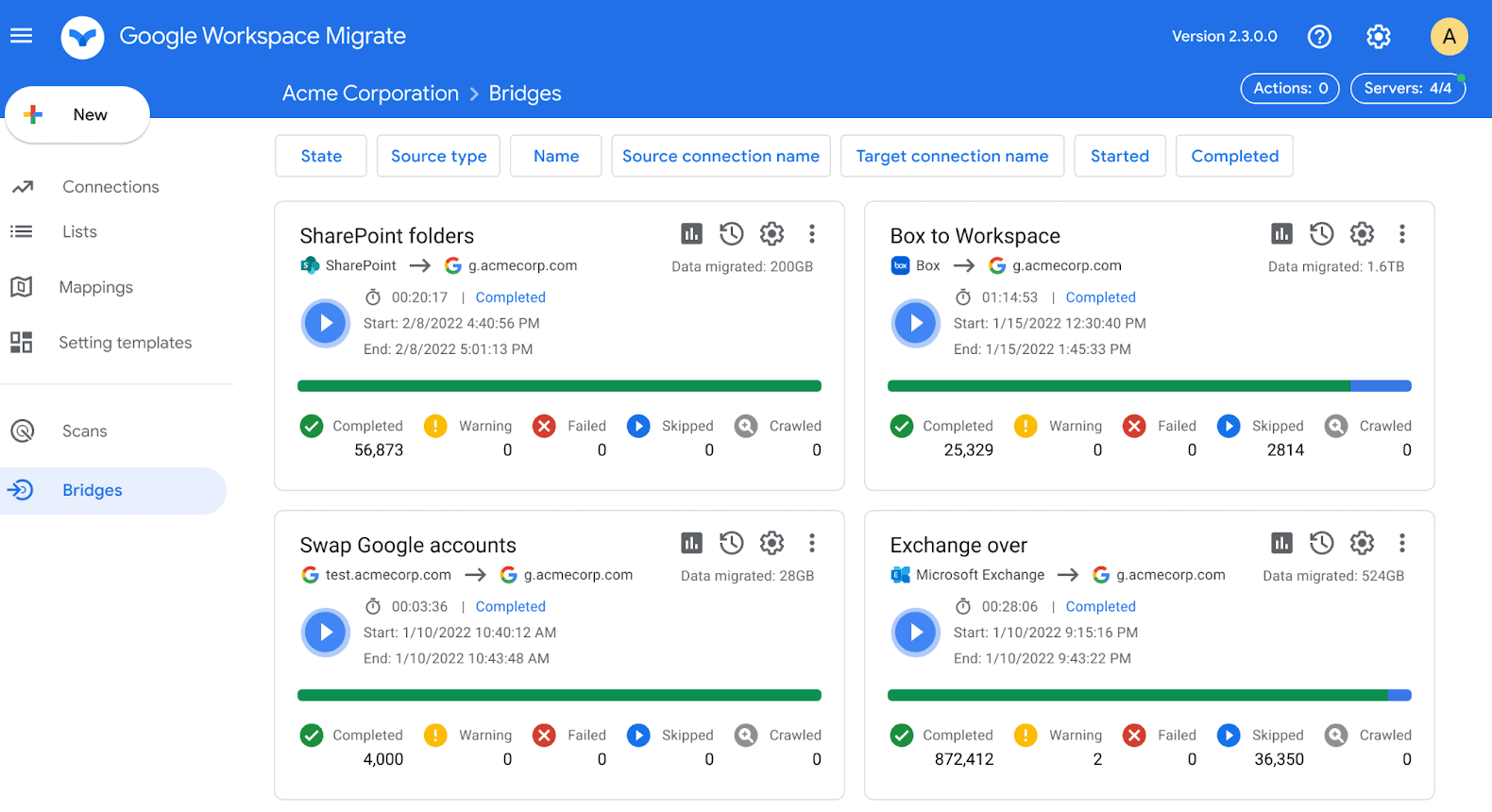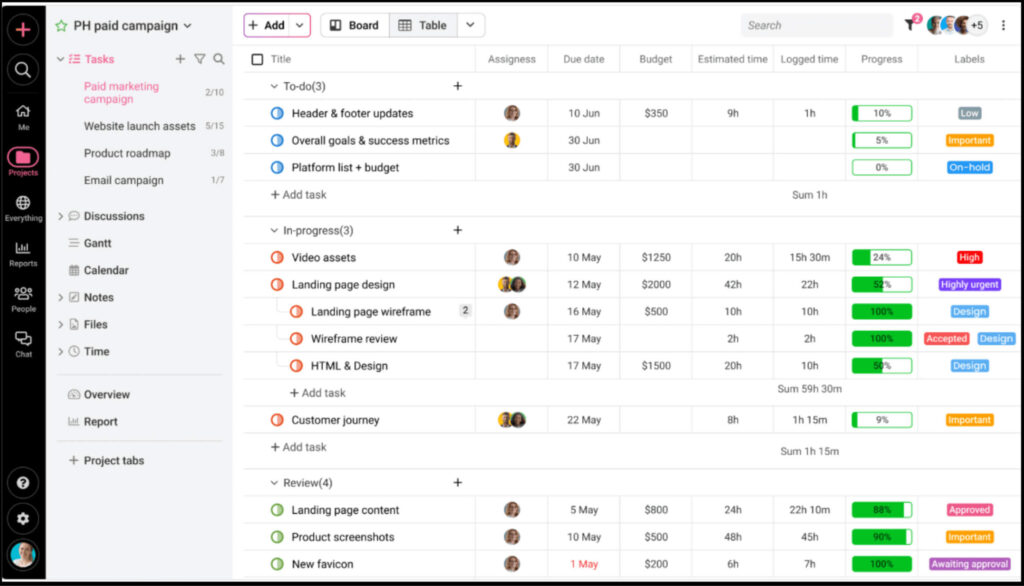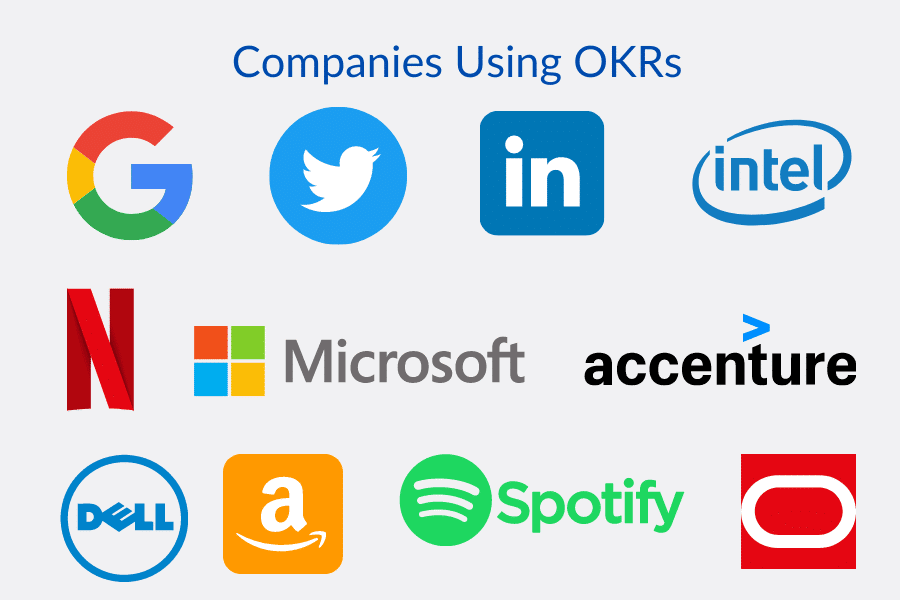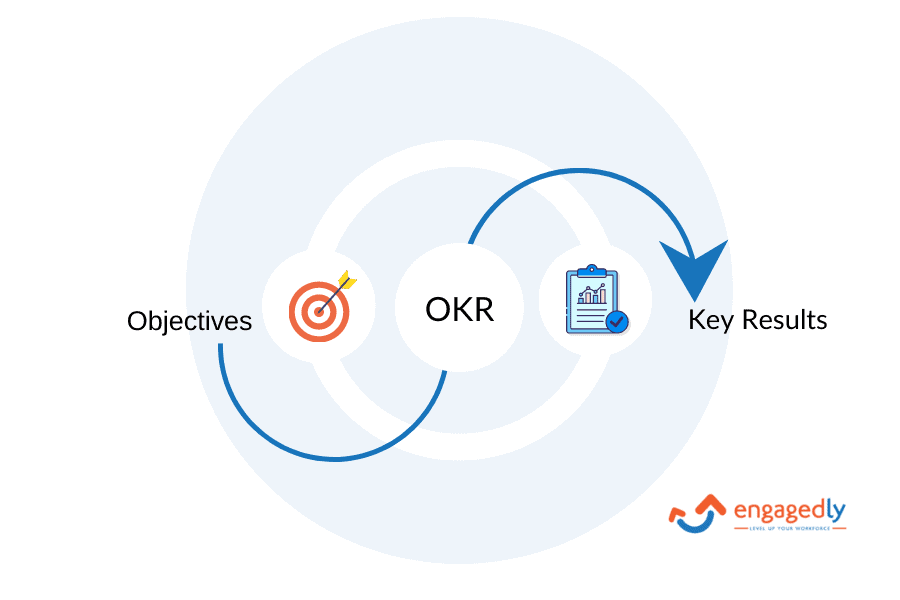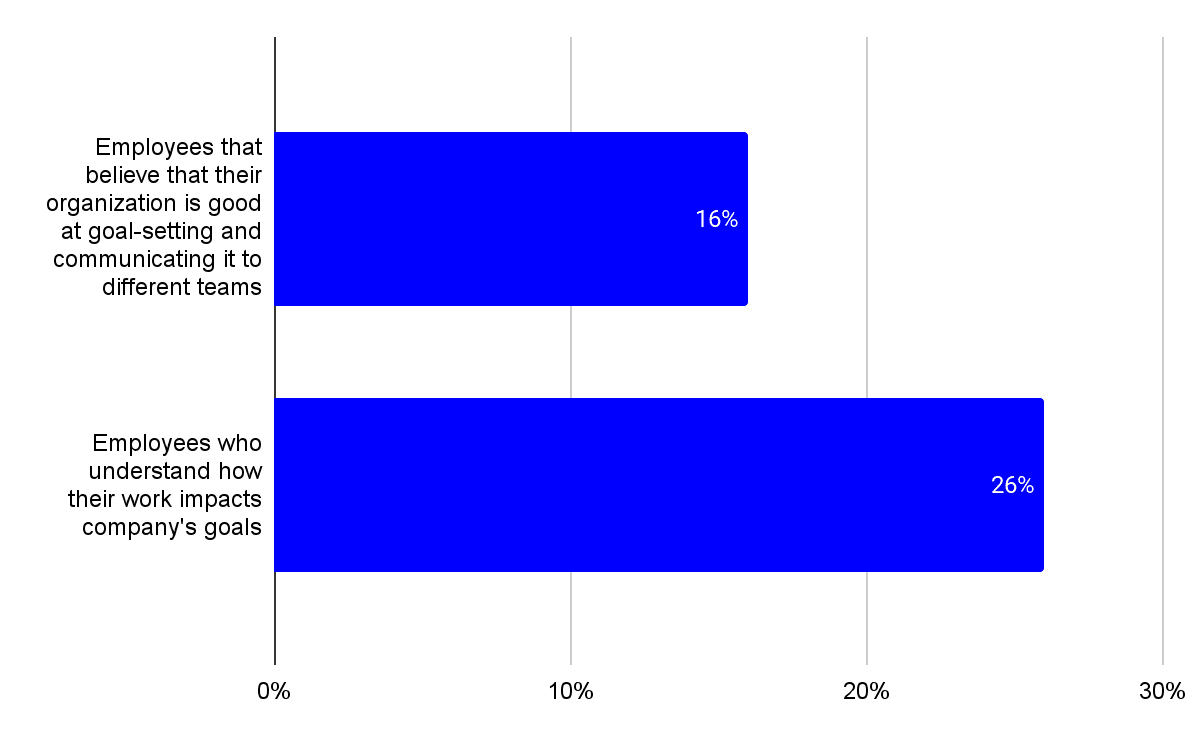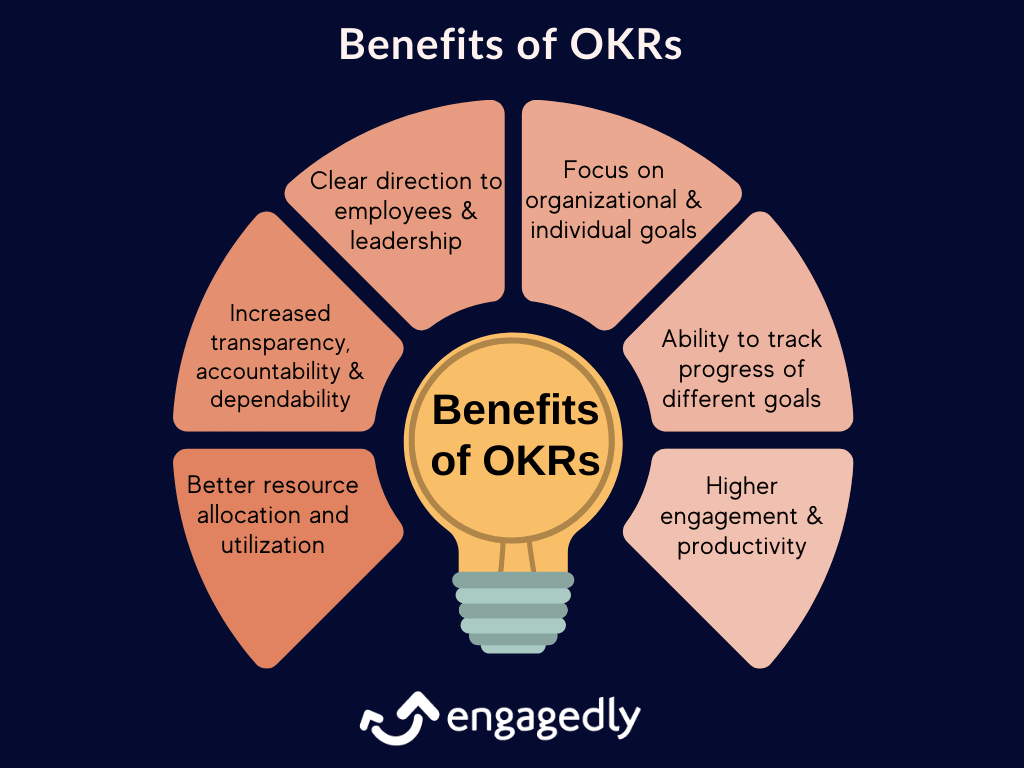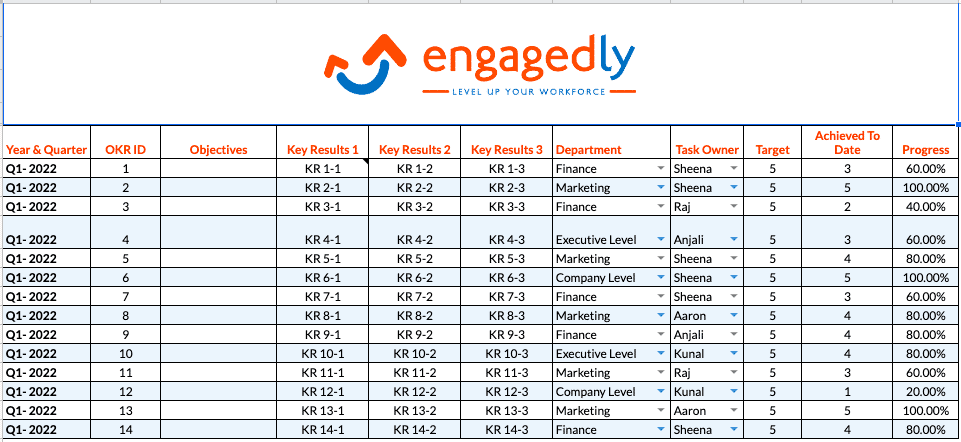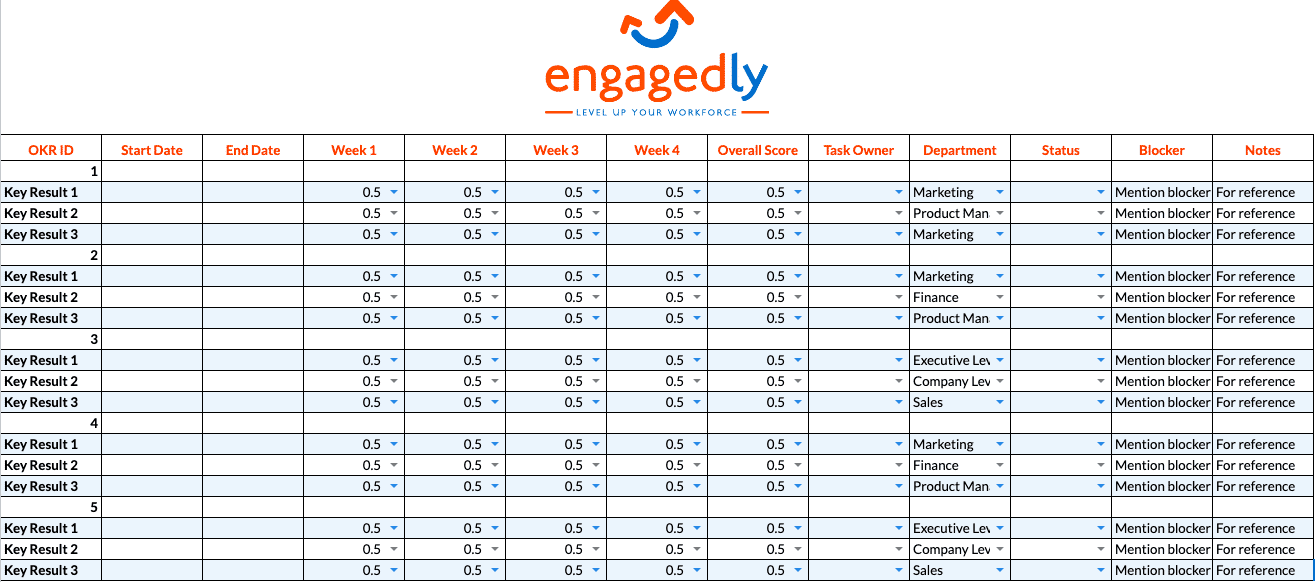Introduction To OKRs
“Setting goals is the first step in turning the invisible into the visible.” — Tony Robbins
Fierce competition, ever-changing technology, and a capricious business landscape, coupled with the great resignation and aftermath of the pandemic, are the leading factors that are shaping global business.
In this uncertain environment, how are organizations keeping pace with growth and development?
While goal setting helps organizations keep track of their performance, it is essential to involve every employee in organizational success. So, how do you ensure that the entire workforce is committed to the organization’s goals and create initiatives that help meet those goals on time?
One of the ways that organizations can create, implement, and measure goals, is by adopting the OKR framework. It is one of the most popular and effective techniques that is used by organizations to achieve ambitious and aspirational goals. Through this framework, leaders and managers can keep track of employee initiatives and ensure their time and effort go into the most productive activities.
For decades, organizations have been using different approaches and methodologies to create and track employee goals. While there are multiple approaches available for goal setting, OKRs are one of the most widely appreciated and widely accepted throughout the world. It helps in articulating the organizational goals into simple objectives and provides measures to track and check the progress of every employee. Furthermore, it increases transparency in the organization and makes departments, teams, and individual employees more accountable for their key results.
As organizations are steering through pandemic-led challenges, it is difficult to track the progress and inputs of every employee. Moreover, setups like work-from-home and hybrid environments create barriers to communication, collaboration, and connection, which ultimately leads to less productivity and engagement. OKRs are a great mechanism to tackle such challenges and offer insights into employees’ deliverables.
Before we dive deeper into the intricacies of objectives and key results, let’s take a closer look at what it means to the organization and how it provides actionable insights to leaders.
OKR Templates
An OKR template is a document that helps organizations, teams, and individuals set up challenging and ambitious goals that are aligned. Also known as the OKR tracking template, it provides great insights into the achievements of team members and helps managers constantly track the progress of different goals.
The leading industrial and HR experts at Engagedly have created a number of OKR templates that accompany different aspects of goal setting and tracking. You can customize these templates to use them for your organization and keep track of the most important organizational goals.

What Are OKRs?
“One: set inspiring and measurable goals. Two: make sure you and your team are always making progress towards that desired end state. No matter how many other things are on your plate. And three: set a cadence that makes sure the group both remembers what they are trying to accomplish and holds each other accountable.” — 1, Author of Radical Focus.
Objectives and Key Results” (OKRs) is a goal-setting and leadership framework. With OKRs, businesses can communicate their desired outcomes and identify key milestones to achieve them. OKRs help companies align their teams with their overall strategy and drive meaningful progress towards their goals.
It became a globally accepted and acclaimed strategy after Google started using it in the 1990s’. Thereon, it has found its way from Silicon Valley to innumerable startups and the world’s leading organizations, like Microsoft, Dell, Baidu, and Adobe.
But what makes it different from the other goal-setting methodologies like MBO (management by objectives) and SMART goals? Even though OKRs originated from MBOs, there are multiple differences in the structure, approach, goal review frequency, and degree of autonomy. OKRs help define the success strategy of the organization while encompassing the “What and How”, meaning they highlight the organizational objectives to be achieved and also provide a set of measures as key results.
To have a clear understanding of how OKRs impact the organization, let us first look at its components.
Also Read: OKRs for new hires
Decoding OKRs
OKR is a great leadership exercise that can be conducted either monthly or quarterly. It helps align the efforts of resources toward achieving organizational goals by clearly outlining their objectives and the quantifiable actions necessary to achieve them. Keeping the focus on some specific and major objectives makes it easier to track their progress and ensures that the workforce is committing their efforts to achieving them.
What Are Objectives?
In simple terms, objectives are what is to be achieved. They are short, inspirational, organized, and clearly defined goals that lead to major changes in the organization. Objectives are aligned throughout the organization and are qualitative. Properly designed and effective objectives ensure that the workforce does not lose sight of the goals and puts their maximum effort into them.
The process starts with leadership deciding on 3-5 objectives to be accomplished. Then the departments and various teams under them set their own objectives based on the organizational objectives. The crux is to ensure the achievement of organizational objectives by channelling the efforts of every team member.
An example of an objective: Increase overall traffic to the website blog
Qualities Of Objectives
Every objective in the OKR bears some unique qualities. It is crucial to understand them to set relatable and clear objectives. Some of them are discussed below.
- Very Clear: It is critical to have clear, unambiguous, and direct objectives that are understandable by every employee in the organization. They should be written in a manner that is easily interpretable and quickly understood.
- Challenging: Challenges make teams and departments in an organization collaborate and work towards the mission. You can either bore your employees by making them work on something easily achievable, or you can flex them by putting a challenging objective in front of them. But it is important to ensure that objectives are not impossible to achieve, as this may lower the morale of the team and put them off track.
- Actionable: Some objectives put your team to the test and offer them something challenging and actionable to work on and then some objectives seem vague and will put your team off. Creating actionable objectives is the key to imbibing enthusiasm in your employees.
- Inspiring: Your employees should be energized while working toward your goals. By setting inspiring objectives, you can increase employee engagement and productivity and ensure they have something to look forward to.
Also Read: OKRs for healthcare professionals
What Are the Key Results?
Key results are a mechanism to measure the achievement of the objectives. Usually, every objective is followed by 3-5 key results that help in its accomplishment. They are measurable, specific, time-bound, and verifiable. They are signifiers that the objectives are in place and they support their evaluation by everyone in the organization.
Additionally, organizations create scoring systems to evaluate the key results. Usually, the system is in the form of a score varying from 0 to 1. The movement on the scale indicates the achievement of the key results.
Examples of key results
Below are the sample key results required to achieve the objective of increasing the overall traffic to the website blog.
- Increase year-on-year traffic to the website by 100%
- Optimize 50 articles every month
- Publish 70 articles every month
Qualities Of Key Results
For key results to be effective and actionable, they should have the following qualities in them.
- Measurable And Quantitative: Key results should be easily measurable in a unit or scoring system as defined by the organization. It should highlight the progress of the team or an individual towards the defined objective.
- Supports Accomplishment Of Objectives: Achieving key results should be directly linked to objectives. A key result cannot exist on its own and must be related to the team or individual objectives.
- Clear: Key results should be clearly defined and easily understood by the teams and individuals. The initial value and target score should be stated while setting the key results.
- Time-bound: Setting a timeframe helps employees stay focused on the activities. Hence, it is important to fix the start and end of all the key results. All team members must be notified about the dates of key result activities.
OKRs vs KPIs: What Is the Difference?
One of the most common questions leaders ask is how OKRs are different from KPIs. While both are important, they serve very different purposes.
KPIs or Key Performance Indicators are business metrics that track ongoing performance. They measure how well a process is running. OKRs on the other hand are designed for change and improvement. They are meant to push teams beyond the status quo.
For example, revenue growth, customer retention, and churn rate are KPIs. They show business health. But an OKR could be to improve customer experience or enter a new market. The key results then define how that change will be measured.
In simple terms:
KPIs track performance.
OKRs drive progress.
High performing organizations use both. KPIs to monitor business stability and OKRs to fuel strategic growth.

History Of OKRs
The history of OKRs goes back to 1974, when Peter Drucker2, an Austrian-American management consultant and business enthusiast, invented Management By Objectives, popularly known as MBO. It became the predecessor of OKRs. Drucker’s purpose was to enhance the productivity and performance of an organization by introducing objectives that were agreed upon both by the leadership and employees.
It was in the 1970s that the co-founder and CEO of Intel Corporation, Andy Grove3, revolutionized the concept of objectives and key results. He used this concept to enhance the performance of Intel and increase revenue by manifolds. He used the MBO framework and tied the objectives with key results to create business excellence.
In 1975, John Doerr joined Intel and learned the concept of OKRs. He found it to be immensely useful in achieving objectives and empowering the employees. He then went on to teach the concept to the founders of Google, Larry Page and Sergey Brin, as an advisor while working at the venture capitalist firm, Kleiner Perkins.
At that time, Google was in its initial stages and quickly adopted the concept. Since then, thousands of companies, from multinationals to startups and even kindergartens, have adopted OKRs and used them to become tremendously successful.
Also Read: Tips to set up OKRs during onboarding
Types Of OKRs
There are two types of OKRs: committed OKRs and aspirational OKRs. Committed OKRs are objectives that are achievable and realistic, while aspirational OKRs are more challenging and ambitious. Both have different purposes and methods for achieving them.
Categorization of OKRs is done based on two questions: the first one is “What does the organization want to achieve?” and the second one is “How do we achieve it?”. By answering these questions, leaders can segregate the OKRs into two baskets: committed OKRs and aspirational OKRs.
Understanding the differences between the types of OKRs helps organizations organize their resources and adopt the methodology that is most suitable for bringing in the key results, driving culture change, and increasing employee engagement. As the purpose of the OKRs is to align the resources towards the most important organizational priorities, it is therefore important to categorize the OKRs to get the most out of the time and efforts of the employees. Let us understand the differences between them and which methodology works best for the organization.
Committed OKRs
Also known as “roof shot goals,” these OKRs highlight the focus areas where the teams are expected to have a 100% achievement rate. An organization sets committed OKRs to focus the efforts of teams on such parameters whose achievement is critical to the success of the organization.
Even though these OKRs are ambitious, they are still realistic and achievable. Hence, the teams are expected to deliver 100% on them. In a scenario where a department or a team finds that the committed OKR cannot be achieved in the current cycle, they must consult with the leadership and create solutions and alternatives to get the goals back on track.
Please note that there is no room for failure in committed OKRs. They represent the utmost priorities of the organization. Team members need to put their heads together to ensure the achievement of the objectives.
Aspirational OKRs
Aspirational OKRs, in contrast to committed OKRs, are stretch goals which are impossible to achieve in a given cycle. The purpose of creating them is to push the departments, teams, and individuals to go further than the committed goals and think better in their approach and execution. Also known by the name “moonshots,” aspirational OKRs drive team efforts towards creativity and innovation. As long as the organization sees considerable and meaningful success, falling short on the achievement of aspirational OKRs is not considered a problem.
Having a 100% achievement rate in aspirational OKRs is rare, and it turns out that if the teams were able to achieve it, then the OKRs weren’t aspirational. In such a scenario, an organization needs to work on improving the methodology of setting OKRs.
Committed Vs Aspirational OKRs: How To Choose?
A 4 conducted by the Economist Intelligence Unit (EIU) with 500 senior executives from organizations with revenues of $1 billion or more found the following about goal setting.
- Right implementing goals is critically important: 90% of the respondents shared that they failed to achieve all of their strategic business goals of wrong implementation.
- Workforce capabilities define the success: 55% of executives found their business exposed to competitors because of inadequate delivery capabilities.
The above statistics highlight the importance of goal setting in the workplace and how it should be done in tandem with workforce capabilities. That’s why selecting the right mix of OKRs is important for organizational success. While an organization may want to have only aspirational goals to push their team to work hard and achieve more, having only aspirational OKRs can demotivate the team and exhaust them for never achieving their targets.
On the flip side, having only committed OKRs will inhibit the innovation, creativity, and problem-solving abilities of the team. They will never be attuned to failure and will be discouraged from risk-taking.
The best approach to selecting aspirational or committed OKRs is based on the organizational culture and strategy. For innovative organizations like Apple, Alphabet, and Microsoft, going beyond the comfort level is imperative, and setting aspirational OKRs is a must. And for organizations that are more into operational activities, committed OKRs will serve the purpose. However, in the long run, as the organization grows, it is crucial to have the right mix of aspirational and committed OKRs to pivot the organization towards success.
Also Read: Top Companies That Adopted OKRs
Benefits Of OKRs: Why Do You Need Them?
OKRs are the key to successful business planning. Organizations that have implemented OKRs found it to be immensely useful in creating an impact on the culture, business outcomes, engagement, and communication. Let us explore some of the benefits of using OKRs.
OKRs are the key to successful business planning. Organizations that have implemented OKRs have found them to be immensely useful in creating an impact on the culture, business outcomes, engagement, and communication. Let us explore some of the benefits of using OKRs.
Business Success
Time and again, it has been proven that organizations that opted for OKRs had tremendous success. The biggest benefit of OKRs lies in making organizations more agile and transparent. It aids in streamlining employees’ efforts to achieve real-world business outcomes.
By giving ownership to the teams to set their own objectives in cadence with the organizational goals, it increases accountability and makes them feel involved in the decision-making process. There is no doubt that organizations like Google, Netflix, and Microsoft have embraced OKRs and focused their efforts on achieving specific goals.
Strategic Alignment

Chris Zook and James Allen, in their book “ 5” mention that between 1988 and 1998, out of 1,854 large corporations they surveyed, seven out of eight could not achieve profitable growth. Yet 90% of these organizations had detailed plans for growth.
The startling statistics highlight how important it is to align organizations and employees with goal setting. While you are burning the midnight oil to prepare plans for growth, not having the goal alignment will not lead the organization to its desired objectives.
OKRs help leaders, managers, and individuals align their efforts and focus on the most important goals of the organization.
Cultural Shift
For long, organizations have focused on output rather than focusing on outcomes. While many leaders still use the terms interchangeably, there is a lot of difference between them. In simple words, output is what the organization or a team does, and an outcome is the change accompanied by the output.
By focusing on outcomes, OKRs help drive employee engagement, higher performance, and transparency in the organization. When continued for a long time, it embeds into the organizational culture and brings purpose, commitment, and innovation into the system.
Clear Communication
As per a report6 by HBR, around 95% of employees are unaware of the organizational strategy. The key to connecting, empowering, and engaging employees is clear communication. An organization that fails to communicate its objectives clearly, suffers losses and employee disengagement.
Using OKRs can solve the challenges of communicating organizational, departmental, and individual goals to every employee. Weekly and monthly check-ins help create a communication channel to highlight any issues in the progress of any objectives.
Also Read: 10 Best employee feedback tools to track performance

OKR Process: How To Get Started With OKRs
The purpose of writing and implementing OKRs is to align the efforts of resources towards the achievement of core organizational objectives. They help bring purpose and meaning to the organization and offer employees something to look forward to. Even though all organizations create short-term and long-term business strategies, only a handful are able to execute them effectively and efficiently. Furthermore, non-alignment of resources with the objectives leads to substandard results and ineffective business delivery.
Most organizations opt for OKRs to bring accountability, transparency, and alignment to the system to implement and execute business strategies. It is important to have leadership involved in the end-to-end process to get actionable results and bring substantial change to the organization.
Creating and implementing OKRs can be cumbersome. It requires integration of teams and leadership to understand the complex problems to be solved and the mechanisms to follow. Let us now understand the process of getting started with OKRs.
The Ultimate Goal
A company’s ultimate goal is a pivotal point for the whole workforce. Departments and teams create their OKRs based on the objectives set by the leadership team. Hence, it is crucial to understand which objectives will solve the organizational challenges and which ones will offer growth opportunities. While there can be innumerable problems to tackle, concentrating on the mission and vision of the organization will help narrow down the most important aspects of organizational growth.
An example of an ultimate goal could be “to become the most preferred IT training provider in the APAC region.”
The best way would be to convert your mission and vision into overarching objectives and key results. This will provide a focus area for various departments and teams to create their OKRs that will support and contribute towards fulfillment of the ultimate objectives.
OKR Cadence
The frequency with which the organization and teams set their OKRs is known as the cadence. Usually, there are two cadences in OKRs: quarterly and annually. As organizational objectives are directional and take a longer time to accomplish, their cadence is set annually.
Departmental and team OKRs are more actionable and are set quarterly. The short-term cadence of departmental OKRs helps leadership change the strategy and direction if they are not contributing towards organizational objectives.
Setting an OKR cadence requires meticulous planning and understanding of the business environment. Refer to the following points while selecting the cadence:
- Uncertain market conditions require setting up a short cadence to accommodate the recurrent changes.
- For startups that aim to achieve more in less time, it is preferable to set up a monthly or quarterly cadence.
- For organizations that are prone to technological changes and stiff competition, a shorter cadence will work well.
- Cultural and behavioral changes in the organization can be achieved through a short OKR cadence.
- A long cadence is generally suitable for large and stable organizations that are prone to sudden changes in the business environment.
Writing Organizational Objectives
Having a single objective will keep the energy and efforts of the whole workforce focused and channeled. However, based on the industry, size, and growth prospects, an organization can create 3 to 5 objectives after taking input from various teams.
It is important to involve all the key stakeholders in order to share their inputs regarding the most important organizational objectives for the next 12 months. The inputs collected from employees have to be evaluated against the company’s strategy and market position and then converted into objectives. Objectives should be specific, clear, and in agreement with what the organization should achieve in the next 12 months.
Keep the following pointers in sight while writing the organizational objectives.
- Refer to the organization’s mission and vision statements.
- Take past objectives into consideration and look at their key results.
- Understand the most important business priorities that need to be addressed
- Look at the OKRs that are performing well in the current cycle.
- Understand the business and market complexities and decide what could be the pivotal point for the organization.
Writing Departmental And Team Objectives
Now that the leadership has decided the objectives to be achieved, it is time for departments and teams to create their objectives. They need to chart out the activities that will help the organization achieve its long-term objectives. The activities help keep the focus on the most important tasks that are vital for accomplishing the objectives. As team OKRs follow a quarterly cadence, it is important to craft objectives that can be achieved in the given cycle.
Setup OKR Scoring Method
How will you understand the progress your team has made towards an objective? To determine how well a team delivers on an objective, it is important to fix a scoring method.
There are different scorecards used by organizations to indicate progress. One such method is using a scale of 0 to 1, where 0 indicates no progress made by the department or a team on the objective. One can also use a 10 point scale for scoring OKRs.
The next step in measuring progress is labeling or benchmarking the scorecard. Labels help in understanding the overall accomplishment of an objective. For example, you can use labels like “30–40% as average progress and 50–75% as good progress.”
How OKR Scoring Actually Works in Practice:
Most organizations use a scoring range between 0.0 and 1.0 to track progress on key results.
A score between:
0.0 to 0.3 means low progress
0.4 to 0.6 means moderate progress
0.7 to 1.0 means strong progress
Interestingly, a final OKR score of around 0.7 is often considered successful for aspirational OKRs. It shows that the team stretched themselves and delivered meaningful progress even if they did not hit every target perfectly.
For committed OKRs however, the expected score is closer to 1.0 since these goals are critical to business operations.
The purpose of scoring is not to judge performance. It is to create learning. Teams review what worked, what did not, and what should change in the next cycle.
Communicate OKRs To Everyone
Sharing organizational and teams’ OKRs publicly helps in increasing the transparency in the system. Additionally, it brings more visibility regarding the organization’s most important priorities and helps employees collaborate to achieve their objectives.
Track OKRs

Successful implementation of OKRs lies in frequently tracking their progress by weekly check-ins and conducting a quarterly OKR review at the end of each cycle. OKR tracking assists in the following ways: understanding progress made on objectives, addressing any shortcomings, resolving any challenges encountered by the team, and motivating the team to continue putting in efforts.
Also Read: 10 Best tools for employee goal setting
Common OKR Mistakes to Avoid
Even the best OKR frameworks can fail if they are implemented poorly. Here are some of the most common mistakes organizations make.
Setting too many OKRs
When everything is a priority, nothing is. Teams should ideally focus on three to five objectives per cycle.
Treating OKRs as a task list
OKRs are not daily to do items. They are strategic outcomes. Tasks belong in project management tools, not inside OKRs.
Linking OKRs directly to compensation
This discourages risk taking and honest reporting. OKRs should encourage learning, not fear.
Skipping regular check ins
Without weekly or biweekly reviews, OKRs lose momentum and relevance.
Copying OKRs from other companies
Every business has different priorities. What works for one company may not work for another.
Avoiding these mistakes dramatically increases the chances of successful OKR adoption.
OKR Best Practices
OKRs are an impressive tool to track and measure the progress of organizational objectives. But there are times when things can go haywire. And to prevent such events, it is best to follow OKR’s best practices that help avoid any hiccups and inefficiencies in the process.
Onboard An OKR Champion
Creating and implementing OKRs is a challenging process, and many organizations fall prey to poor OKR adoption and implementation. To successfully incorporate OKRs into culture and business, it is crucial to have an OKR champion. A person with expertise in the adoption, rollout, modulation, and review of the OKRs helps channel and streamline the processes effectively. Furthermore, having an OKR champion will reduce the risk of running an incompetent and ineffective process.
Communicate OKR Benefits
To get the full range of benefits from the OKR methodology and framework, every employee in the organization must be well-informed about the process. By communicating the OKR benefits through different communication channels, leadership can ensure higher adoption and more visibility in the system.
Autonomy To Set Employee OKRs
Involving employees in setting their own OKRs increases their accountability, transparency, and trust towards the organization. Moreover, it will help employees choose the projects, tasks, and challenges that are more suitable for their skills and professional growth. Managers can hold discussions with the team members to understand their expectations and help them align their OKRs towards organizational objectives.
Hold Organization-wide OKR Review
To understand the overall impact of the OKR on the organization, it is important to hold an organization-wide review that discusses the achievements, setbacks, and improvement measures for the next OKR cycle. Such reviews provide OKR champions with insights to understand where the process is lacking and to suggest changes. It is important to note that the whole workforce should be part of the review meeting to incorporate the values of OKRs in them.
Mix Of Aspirational And Committed OKRs
As discussed in the previous sections, having the right mix of committed and aspirational OKRs keeps the workforce motivated and drives them towards organizational success. Additionally, labelling OKRs as committed and aspirational will allow employees to understand how much effort they have to put into a particular objective.
Incorporate Learning In The Next OKR Cycle
The weekly check-ins and quarterly OKR reviews provide valuable insights to the leadership to enhance the effectiveness of the process. Before setting the OKRs for the next cycle, it is important to look back at the feedback collected from the process and the managers and integrate them into the system.
Use Both Top Down And Bottom Up OKRs
An organization that is new to OKRs will naturally use the top-down cascading method, meaning the objectives are set up by the leadership and they trickle down to different teams and finally to the individual OKRs. On the other hand, the bottom-up approach allows employees to set up OKRs and convince the management of their adoption.
Much research has pointed to using a mix of both top-down and bottom-up approaches. It helps in keeping up the motivation and involvement of employees in their work and also ensures the leadership vision and objectives are met.
Performance Review, Promotion, And Compensation
The purpose of creating OKRs is to align the efforts of the resources in reaching organizational objectives. But some organizations make the mistake of tying compensation, promotions, and performance reviews to OKRs, which can kill their essence of transparency and accountability. Employee performance evaluation is an entirely different aspect of a business and must not be married to OKRs.
The above pointers help to avoid common OKR mistakes that organizations make while creating and implementing OKRs.
Also Read: The Ultimate Guide to 30 60 90 day Performance Reviews
OKR Examples
Setting up OKRs can be challenging for first-timers. But with experience and due diligence, one can create OKRs that bring in results. It is important to refer back to the past OKRs to avoid mistakes. Additionally, OKR examples can also provide quick insights to set up goals for various departments and teams.
Below are some of the OKR examples to kick-start the process.
OKR Examples For HR
| Objectives | Key Results |
|---|---|
| Create an employee wellness program |
|
| Improved training and development opportunities for managers |
|
OKR Examples For Information Technology
| Objectives | Key Results |
|---|---|
| Enhance client data security measures |
|
| Reduce website and application load time |
|
Product Management OKR Examples
| Objectives | Key Results |
|---|---|
| Increase the count of daily active users on the application |
|
| Increase reliability and scalability of the product for external stakeholders |
|
Sales OKR Examples
| Objectives | Key Results |
| Increase quarterly revenue to $500,000 |
|
| Increase high net-worth corporate client base |
|
Customer Success OKR Examples
| Objectives | Key Results |
| Provide state-of-the-art customer enablement tools |
|
| Increase customer involvement activities |
|
OKR Examples For Operations
| Objectives | Key Results |
| Increase organizational productivity |
|
| Incorporate a learning management system to increase productivity and efficiency |
|
Also Read: The ultimate guide to engagement survey + template
Industry Specific OKR Examples
OKR Examples for SaaS Companies
Objective: Improve customer retention
– Increase renewal rate from 75 percent to 88 percent
– Reduce average support resolution time from 8 hours to 3 hours
– Launch three new customer education programs
Objective: Accelerate product adoption
– Increase feature adoption by 40 percent
– Increase weekly active users by 30 percent
OKR Examples for Manufacturing
Objective: Improve production efficiency
– Reduce machine downtime by 20 percent
– Improve on time delivery from 85 percent to 95 percent
– Reduce defect rate by 30 percent
OKR Examples for Healthcare
Objective: Improve patient satisfaction
– Increase patient feedback score from 3.8 to 4.6
– Reduce average wait time by 35 percent
– Implement digital appointment scheduling across all clinics
How to Choose the Right OKR Software
Spreadsheets work in the early stages but they quickly become difficult to manage as teams scale. The right OKR software helps automate tracking, increase visibility, and simplify reviews.
When selecting an OKR tool, look for:
- Easy goal creation and alignment
- Real time progress tracking
- Automated check ins and scoring
- Integration with performance management
- Clear reporting and dashboards
A strong OKR platform should not just track goals. It should connect goal setting with feedback, learning, engagement, and performance conversations.
Final Thoughts
OKRs have gained phenomenal success in the last two decades. From startups to multinationals, thousands of organizations have embraced it to reach their ambitious and most challenging goals. Due to its simplicity in setting up and tracking key business results, many renowned leaders have used it for personal and professional success.
Technically advanced OKR software, such as Engagedly, makes it easier to adopt and implement OKRs quickly. It offers excellent insights into understanding the progress of your important objectives and provides an execution-focused approach to aligning and tracking performance outcomes across the organization.
FAQs
What does OKR stand for?
OKR stands for Objectives and Key Results. It is a goal setting framework used to define what you want to achieve and how you will measure success.
How often should OKRs be set?
Most organizations set OKRs quarterly. Some also define annual company level OKRs.
What is a good OKR score?
For aspirational OKRs, a score of 0.6 to 0.7 is considered successful. For committed OKRs, teams usually aim for closer to 1.0.
Can small businesses use OKRs?
Yes. OKRs work very well for startups and small teams because they create focus, clarity, and fast execution.
Are OKRs better than KPIs?
They serve different purposes. KPIs track performance. OKRs drive improvement and strategic change.




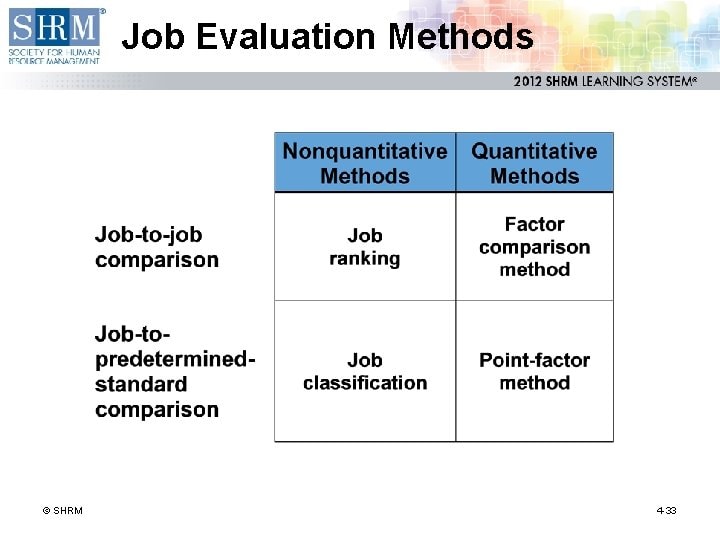










 A matrix organization is a management method that integrates both functional and project-oriented approaches. The matrix structure involves dual reporting lines, where the staff members usually report to both a functional manager, who supervises their skills development in a specific department or discipline, and a project manager, who directs them to realize the project’s goals and deadlines.
A matrix organization is a management method that integrates both functional and project-oriented approaches. The matrix structure involves dual reporting lines, where the staff members usually report to both a functional manager, who supervises their skills development in a specific department or discipline, and a project manager, who directs them to realize the project’s goals and deadlines. 

















